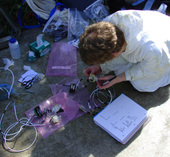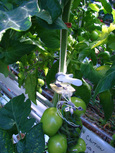Highlight
BackYard Farm IGERT Collaboration
Achievement/Results
Our third cohort of IGERT trainees partnered with Backyard Farms (BYF) of Madison, Maine this year for the testbed course. Their objective was to develop and implement an inexpensive photosynthetically active radiation (PAR) sensor that yields results comparable to a commercial PAR sensor. BYF is a large commercial greenhouse that specializes in growing vine-ripened tomatoes in Maine year round in an environmentally friendly greenhouse. Both the quality and quantity of radiation received by plants affect productivity, so the students task was to perform an in-depth analysis of spatial and temporal variations in light quality and quantity from both artificial and natural light sources.
PAR (µmol/m-2/s) is defined as the amount of radiation in the 400 to 700 nm portion of the light spectrum. Within PAR, there are two distinct spectrums that are most useful to plants: blue light (400-500) promotes leaf growth and red light (600-700) promotes flower and fruit formation. BYF utilizes a central greenhouse management program, Synopta®, to continuously monitor conditions including solar radiation and PAR via centrally located sensors above the tomato canopy. The quality (amount of light within the photosynthetically useful spectrum) and intensity of both natural and synthetic light sources varies with plant location and canopy depth. Placing several PAR sensors at multiple locations within the canopy would provide more accurate estimations of total incident radiation received by the plants; however, the cost, size and networking capacity of commercial PAR sensors are prohibitive. In response, the class designed an inexpensive wireless network of photodiode arrays to closely approximate PAR within the canopy using off-the-shelf components, software solutions and data mining techniques. Two photodiode arrays were developed for this purpose: a nonselective (NS) array consisting of a NS photodiode and a NS photodiode with an IR pass filter (>730 nm), and a selective photodiode array that also included blue selective (400-550 nm) and red selective (620-700 nm) photodiodes. These arrays were attached to sensor boards on wireless motes that transmitted to a base station where the data was collated. A total of eight arrays (four selective, four NS) were deployed at BYF in vertical and horizontal configurations to quantify spatial variations in quality and intensity of natural and artificial light throughout the tomato canopy.
Address Goals
There are two important outcomes from this research: first, the IGERT trainees were able to design and implement a cost-effective selective network as a solution to a commercial need; and second, the data collected from the sensor network during deployment is expected to lead to increased crop productivity and/or decreased energy costs. BYF will have the ability to continue to monitor PAR with finer spatial resolution should they choose to follow the IGERT team’s design recommendations. The partnership between Backyard Farms and the University of Maine IGERT trainees fostered student innovation that met commercial needs, thus highlighting the potential benefits of further business-research collaboration.







